by Jessica Williams
The collaborative artwork Unseeing elegy of the tetrachromats (2021) inverts the familiar trope of simulating nonhuman sensory perspectives for the human-centered spectator. It additionally positions the contributions of artists and biological scientists at the boundaries of their disciplines, in a tension of functional non-consensus. The overarching intention of the work was proposed by lead artist Jessica Laraine Williams (www.jlogos.net), to speculate on a material-cultural sovereignty for avian aesthetes. Her expectation was that these efforts would be insufficient for the intended audience, Australian parrot Platycercus elegans (the crimson rosella); her hope was to invite the birds to engage with an artistic offering, document this encounter and then to report back to human audiences with the results. In between Covid-19 lockdown periods in her home state of Victoria, Australia, she managed to stage her performance with wild parrots over one weekend.

Jessica Laraine WILLIAMS, Alex LAST, Roger ALSOP, Mathew BERG. Unseeing Elegy of the Tetrachromats, 2021. Video and sound, dimensions variable.
This project was conceived as part of Williams’ PhD research into figuration of posthuman imaginaries through boundary work with art, undertaken at the Victorian College of the Arts, Melbourne, Australia. Posthumanist practices recognize that figuring more-than-human subjectivity will always be hedged by our anthropocentric vision. From a critical studies perspective, this limitation can be theorized through questions such as what constitutes art to a given subject? What would nonhuman art look like? Extended to nonhuman animals, an anthropocentric vision of ‘animal art’ tends to seek analogues to those in human artworlds: dance, sculpture, painting, and song. Bird song and courtship displays draw these types of comparisons, particularly. Considering the avian sensorium from an ecological perspective, human vision has been shown to differ in particular biological aspects. Birds possess a higher temporal acuity of vision (also known as flicker fusion frequency, or how quickly these birds can see and navigate their world) and their ability to see into the ultraviolet wave band of light (tetrachromacy, being the condition of colour vision in four dimensions). Temporal acuity rates are known to vary between bird species themselves, eliciting the notion that such variances might be analogous to a ‘secret code’ of signaling intra-species; invisible to predatory birds, for example, but perceptible between birds of the same species. Whilst UV-reflective markings on bird plumage are typically narrated through their mechanism in courtship and fitness signalling, we also contemplate a visual encounter with a colour that remains absent in our human sensorium.
Unseeing elegy of the tetrachromats (2021) was first presented at the ‘Birds and Language’ conference in August 2021, at the University of Sydney, Australia. The work was exhibited as three videos from each of the artist collaborators: Roger Alsop, Alex Last and Jessica Laraine Williams. Each took differing approaches to the initial provocation: what does it mean to make artwork for rosella vision?

Jessica Laraine WILLIAMS, Alex LAST, Roger ALSOP, Mathew BERG. Unseeing Elegy of the Tetrachromats, 2021. Video and sound, dimensions variable.
You can view each of these three contributions via the online exhibition link:
https://birds-and-language.squarespace.com/artists/williams-last-aslop-and-berg
An accompanying conference presentation was recorded by the artists and their interlocutor-collaborator, biological scientist Mathew Berg. The presentation gives an overview of the art-science discourses underlying the work, and documents some of the processes involved in making it:
A peer-reviewed special issue of Unlikely Journal for Creative Arts, Issue 8: ‘Birds and Language’ is forthcoming in November 2022, and will feature further documentation of the work with an accompanying scholarly commentary from contributors. Please visit https://unlikely.net.au/ for further details.

